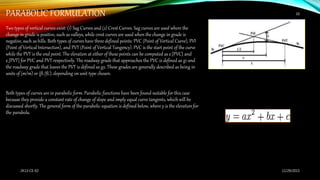This document discusses vertical alignment in road design. It defines vertical alignment as the vertical aspect of the road profile, including crest and sag curves. It describes the basic components of vertical alignment as grade and vertical curves. Grade is the slope of the road expressed as a percentage, while vertical curves are parabolic curves that provide gradual transitions between different grades to allow comfortable driving. The document discusses types of vertical curves such as sag curves at the bottom of hills and crest curves at the tops of hills, as well as symmetrical and unsymmetrical curves. It provides the equations used to design different types of vertical curves.






![EFFECT OF GRADE
The effects of rate and length of grade are more pronounced on the operating characteristics of
trucks than on passenger cars and thus may introduce undesirable speed differentials between the
vehicle types. The term “criticallengthof grade” is used to indicate the maximum length of a
specified ascending gradient upon which a loaded truck can operate without an unreasonable
reduction in speed (commonly 10 mph [15 km/h]). Figure 2-3 shows the relationship of percent
upgrade, length of grade, and truck speed reduction.](https://image.slidesharecdn.com/alignmentinroaddesign-151129183646-lva1-app6891/85/Vertical-Alignment-in-road-design-7-320.jpg)







![GRADE CHANGE WITHOUT VERTICAL CURVES
Designing a sag or crest vertical point of intersection without a vertical curve is generally acceptable where the
grade difference (A) is:
• 1.0 percent or less for design speeds equal to or less than 45 mph [70 km/h]
• 0.5 percent or less for design speeds greater than 45 mph [70 km/h].
• When a grade change without vertical curve is specified, the construction process typically results in a short
vertical curve being built (i.e., the actual point of intersection is “smoothed” in the field). Conditions where
grade changes without vertical curves are not recommended include:
• Bridges (including bridge ends)
• Direct-traffic culverts
• Other locations requiring carefully detailed grades.](https://image.slidesharecdn.com/alignmentinroaddesign-151129183646-lva1-app6891/85/Vertical-Alignment-in-road-design-15-320.jpg)

